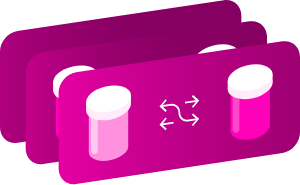Identification
- Generic Name
- Arsanilic acid
- DrugBank Accession Number
- DB03006
- Background
-
An arsenical which has been used as a feed additive for enteric conditions in pigs and poultry. It causes blindness and is ototoxic and nephrotoxic in animals. [PubChem]
- Type
- Small Molecule
- Groups
- Experimental, Vet approved
- Structure
- Weight
-
Average: 217.0542
Monoisotopic: 216.972014544 - Chemical Formula
- C6H8AsNO3
- Synonyms
-
- (p-aminophenyl)arsonic acid
- 4-aminobenzenearsonic acid
- 4-Aminophenylarsonic acid
- 4-Aminophenylarsonsäure
- 4-arsanilic acid
- Arsanilic acid
- Arsanilsäure
- atoxylic acid
- p-arsanilic acid
- External IDs
-
- AS 101
Pharmacology
- Indication
-
Not Available
 Reduce drug development failure ratesBuild, train, & validate machine-learning models
Reduce drug development failure ratesBuild, train, & validate machine-learning models
with evidence-based and structured datasets.Build, train, & validate predictive machine-learning models with structured datasets. - Contraindications & Blackbox Warnings
-
 Avoid life-threatening adverse drug eventsImprove clinical decision support with information oncontraindications & blackbox warnings, population restrictions, harmful risks, & more.Avoid life-threatening adverse drug events & improve clinical decision support.
Avoid life-threatening adverse drug eventsImprove clinical decision support with information oncontraindications & blackbox warnings, population restrictions, harmful risks, & more.Avoid life-threatening adverse drug events & improve clinical decision support. - Pharmacodynamics
-
Not Available
- Mechanism of action
-
Target Actions Organism ULysozyme C Not Available Humans - Absorption
-
Not Available
- Volume of distribution
-
Not Available
- Protein binding
-
Not Available
- Metabolism
- Not Available
- Route of elimination
-
Not Available
- Half-life
-
Not Available
- Clearance
-
Not Available
- Adverse Effects
-
 Improve decision support & research outcomesWith structured adverse effects data, including:blackbox warnings, adverse reactions, warning & precautions, & incidence rates.Improve decision support & research outcomes with our structured adverse effects data.
Improve decision support & research outcomesWith structured adverse effects data, including:blackbox warnings, adverse reactions, warning & precautions, & incidence rates.Improve decision support & research outcomes with our structured adverse effects data. - Toxicity
-
Not Available
- Pathways
- Not Available
- Pharmacogenomic Effects/ADRsBrowse all" title="" id="snp-actions-info" class="drug-info-popup" href="javascript:void(0);">
- Not Available
Interactions
- Drug InteractionsLearn More" title="" id="structured-interactions-info" class="drug-info-popup" href="javascript:void(0);">
-
This information should not be interpreted without the help of a healthcare provider. If you believe you are experiencing an interaction, contact a healthcare provider immediately. The absence of an interaction does not necessarily mean no interactions exist.Not Available
- Food Interactions
- Not Available
Categories
- Drug Categories
-
- Adjuvants, Immunologic
- Alkenes
- Anti-Infective Agents
- Arsenicals
- Compounds used in a research, industrial, or household setting
- Enzyme Inhibitors
- Hydrocarbons, Acyclic
- Immunologic Factors
- Nucleic Acid Synthesis Inhibitors
- Protective Agents
- Radiation-Protective Agents
- Reverse Transcriptase Inhibitors
- Tellurium
- Chemical TaxonomyProvided byClassyfire
-
- Description
- This compound belongs to the class of organic compounds known as aniline and substituted anilines. These are organic compounds containing an aminobenzene moiety.
- Kingdom
- Organic compounds
- Super Class
- Benzenoids
- Class
- Benzene and substituted derivatives
- Sub Class
- Aniline and substituted anilines
- Direct Parent
- Aniline and substituted anilines
- Alternative Parents
- Pentaorganoarsanes/Oxygen-containing organoarsenic compounds/Organic metalloid salts/Primary amines/Organopnictogen compounds/Organic oxides/Hydrocarbon derivatives
- Substituents
- Amine/Aniline or substituted anilines/Aromatic homomonocyclic compound/Hydrocarbon derivative/Organic metalloid salt/Organic nitrogen compound/Organic oxide/Organic oxygen compound/Organic salt/Organoarsenic compound
- Molecular Framework
- Aromatic homomonocyclic compounds
- External Descriptors
- organoarsonic acid (CHEBI:49477)
- Affected organisms
- Not Available
Chemical Identifiers
- UNII
- UDX9AKS7GM
- CAS number
- 98-50-0
- InChI Key
- XKNKHVGWJDPIRJ-UHFFFAOYSA-N
- InChI
-
InChI=1S/C6H8AsNO3/c8-6-3-1-5(2-4-6)7(9,10)11/h1-4H,8H2,(H2,9,10,11)
- IUPAC Name
-
(4-aminophenyl)arsonic acid
- SMILES
-
NC1=CC=C(C=C1)[As](O)(O)=O
References
- 一般引用
- Not Available
- External Links
-
- PubChem Compound
- 7389
- PubChem Substance
- 46508500
- ChemSpider
- 7111
- ChEBI
- 49477
- ChEMBL
- CHEMBL351769
- PDBe Ligand
- ASR
- Wikipedia
- Arsanilic_acid
- PDB Entries
- 1n4f
Clinical Trials
- Clinical TrialsLearn More" title="" id="clinical-trials-info" class="drug-info-popup" href="javascript:void(0);">
-
Phase Status Purpose Conditions Count 2 Suspended Treatment Acute Myeloid Leukemia/Myelodysplastic Syndrome 1 2 Terminated Treatment Atopic Dermatitis 1 2 Terminated Treatment Chemotherapy-Induced Thrombocytopenia 1 2 Unknown Status Treatment Alopecia 1 2 Unknown Status Treatment External Genital Warts 1 2 Withdrawn Treatment Mild to Moderate Psoriasis 1 1 Completed Treatment Human Immunodeficiency Virus (HIV) Infections 1 1, 2 Completed Treatment Condylomata Acuminata/Wart; External Genital Organs 1 1, 2 Completed Treatment Neovascular Age-Related Macular Degeneration (nAMD) 1 Not Available Completed Treatment Human Immunodeficiency Virus (HIV) Infections 3
Pharmacoeconomics
- Manufacturers
-
Not Available
- Packagers
-
Not Available
- Dosage Forms
- Not Available
- Prices
- Not Available
- Patents
- Not Available
Properties
- State
- Solid
- Experimental Properties
- Not Available
- Predicted Properties
-
Property Value Source Water Solubility 11.0 mg/mL ALOGPS logP -0.42 ALOGPS logP -0.17 Chemaxon logS -1.3 ALOGPS pKa (Strongest Acidic) 3.95 Chemaxon pKa (Strongest Basic) 2.73 Chemaxon Physiological Charge -1 Chemaxon Hydrogen Acceptor Count 4 Chemaxon Hydrogen Donor Count 3 Chemaxon Polar Surface Area 83.55 Å2 Chemaxon Rotatable Bond Count 1 Chemaxon Refractivity 36.75 m3·mol-1 Chemaxon Polarizability 16.28 Å3 Chemaxon Number of Rings 1 Chemaxon Bioavailability 1 Chemaxon Rule of Five Yes Chemaxon Ghose Filter No Chemaxon Veber's Rule No Chemaxon MDDR-like规则 No Chemaxon - Predicted ADMET Features
-
Property Value Probability Human Intestinal Absorption + 0.6659 Blood Brain Barrier + 0.8643 Caco-2 permeable - 0.5292 P-glycoprotein substrate Non-substrate 0.8603 P-glycoprotein inhibitor I Non-inhibitor 0.9804 P-glycoprotein inhibitor II Non-inhibitor 0.9897 Renal organic cation transporter Non-inhibitor 0.929 CYP450 2C9 substrate Non-substrate 0.824 CYP450 2D6 substrate Non-substrate 0.8209 CYP450 3A4 substrate Non-substrate 0.7607 CYP450 1A2 substrate Non-inhibitor 0.7044 CYP450 2C9 inhibitor Non-inhibitor 0.946 CYP450 2D6 inhibitor Non-inhibitor 0.9492 CYP450 2C19 inhibitor Non-inhibitor 0.9278 CYP450 3A4 inhibitor Non-inhibitor 0.9412 CYP450 inhibitory promiscuity Low CYP Inhibitory Promiscuity 0.9499 Ames test Non AMES toxic 0.759 Carcinogenicity Non-carcinogens 0.5105 Biodegradation Not ready biodegradable 0.9666 Rat acute toxicity 1.9021 LD50, mol/kg Not applicable hERG inhibition (predictor I) Weak inhibitor 0.9293 hERG inhibition (predictor II) Non-inhibitor 0.9399
Spectra
- Mass Spec (NIST)
- Not Available
- Spectra
-
Spectrum Spectrum Type Splash Key Predicted MS/MS Spectrum - 10V, Positive (Annotated) Predicted LC-MS/MS Not Available Predicted MS/MS Spectrum - 20V, Positive (Annotated) Predicted LC-MS/MS Not Available Predicted MS/MS Spectrum - 40V, Positive (Annotated) Predicted LC-MS/MS Not Available Predicted MS/MS Spectrum - 10V, Negative (Annotated) Predicted LC-MS/MS Not Available Predicted MS/MS Spectrum - 20V, Negative (Annotated) Predicted LC-MS/MS Not Available Predicted MS/MS Spectrum - 40V, Negative (Annotated) Predicted LC-MS/MS Not Available
Targets

Build, predict & validate machine-learning models
Use our structured and evidence-based datasets tounlock new
insights and accelerate drug research.
insights and accelerate drug research.
Use our structured and evidence-based datasets to unlock new insights and accelerate drug research.
- Kind
- Protein
- Organism
- Humans
- Pharmacological action
-
Unknown
- General Function
- Lysozyme activity
- Specific Function
- Lysozymes have primarily a bacteriolytic function; those in tissues and body fluids are associated with the monocyte-macrophage system and enhance the activity of immunoagents.
- Gene Name
- LYZ
- Uniprot ID
- P61626
- Uniprot Name
- Lysozyme C
- 分子量
- 16536.885 Da
References
- Overington JP, Al-Lazikani B,霍普金斯艾尔:有多少drug targets are there? Nat Rev Drug Discov. 2006 Dec;5(12):993-6. [Article]
- Imming P, Sinning C, Meyer A: Drugs, their targets and the nature and number of drug targets. Nat Rev Drug Discov. 2006 Oct;5(10):821-34. [Article]
- Berman HM, Westbrook J, Feng Z, Gilliland G, Bhat TN, Weissig H, Shindyalov IN, Bourne PE: The Protein Data Bank. Nucleic Acids Res. 2000 Jan 1;28(1):235-42. [Article]
Drug created at June 13, 2005 13:24 / Updated at February 21, 2021 18:51



